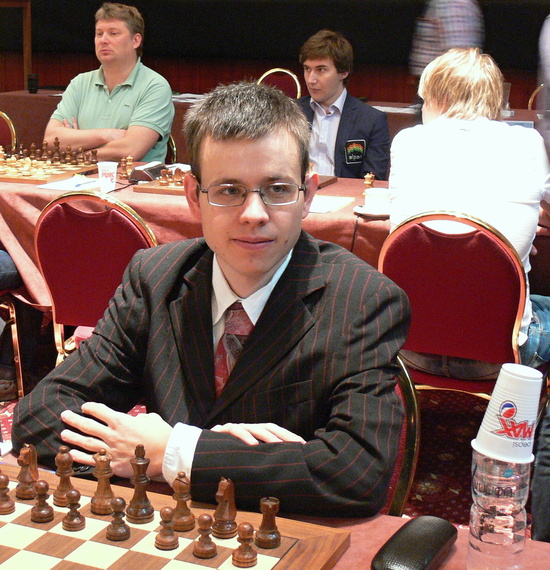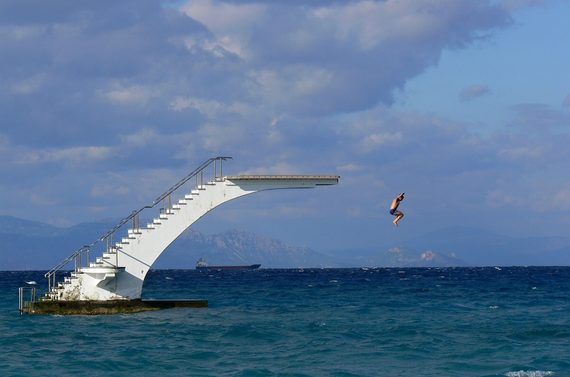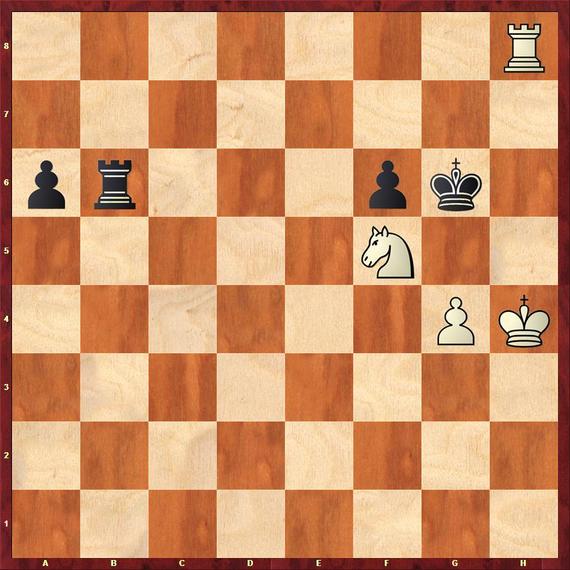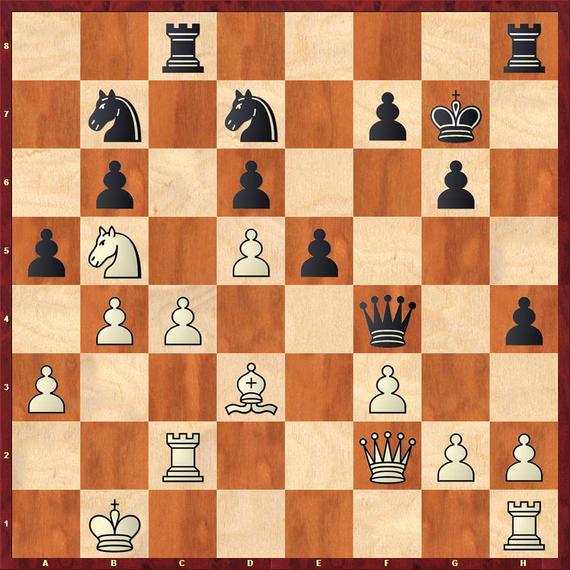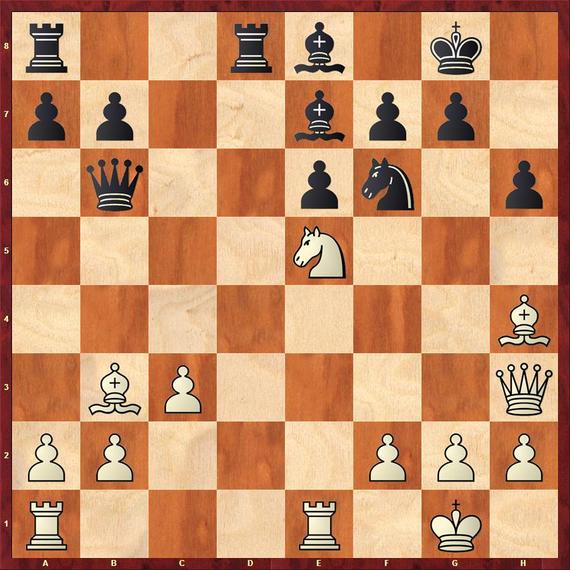Sporting fans love long shots and unexpected triumphs. The first and the last European Chess Club Cups provide proof. In 1976 the German team of SG Solingen shared first place with the powerful Soviet team, Burevestnik Moscow. And last Saturday, against all odds, the players of the Czech G-Team Novy Bor smashed their way to the top and won the Cup in Rhodes, Greece, ahead of strong Russian and Azerbaijani teams.
The winning G-Team Novy Bor from the left: Robert Cvek, Viktor Laznicka, Zbynek Hracek, Krishnan Sasikiran, Radoslaw Wojtaszek (with trophy), Petr Boleslav (captain), Mateusz Bartel, David Navara
Miracle on ice turned into miracle on chessboards when Novy Bor defeated the top seed, the Azerbaijani team of SOCAR 3.5-2.5. To pull off such an amazing feat, you need the stars to be perfectly aligned, play well and have some luck. The oil money from Baku was able to buy a powerful lineup, but on that day the top three boards crashed.
On the top board the Czech champion David Navara, always smartly dressed, played the American-born Italian GM Fabiano Caruana, rated among the world's top six players. It was not a duel between David and Goliath, since Navara is known to be a dangerous opponent to anybody. For example, in the past he defeated the world's best two grandmasters, Magnus Carlsen and Levon Aronian. Caruana decided to take an exchange in the Spanish opening, but his position was not easy to play and his chances to make a draw gradually worsened.
Navara, David (2703) - Caruana, Fabiano (2779)
European Club Cup, Rhodes 2013
61.Bd1
Black has no defense against 62.c7+ Kd7 63.Bg4+ and white queens.
Caruana resigned.
Viktor Laznicka played well on the third board throughout the event. He scored an important victory against the creative Moscow GM Alexander Morozevich, tying the match against the Russian team of Malachite 3-3.
Jumping from joy: Viktor Laznicka
Against SOCAR, Laznicka outplayed the U.S. champion Gata Kamsky, known to be a tough nut to crack.
Laznicka,Viktor (2666) - Kamsky,Gata (2725)
European Club Cup, Rhodes 2013
60.Re8
Black is a piece down a white threatens 61.Re7 and 62.Rg7 mate.
Kamsky resigned.
The Polish GM Wojtazsek provided the third victory against the former world champion and the current FIDE World Cup winner Veselin Topalov of Bulgaria.
Topalov,Veselin (2771) - Wojtaszek,Radoslaw (2698)
European Club Cup, Rhodes 2013
In the Sicilian Najdorf, Topalov didn't get anything going on the kingside and Wojtazsek was able to prevent the break c4-c5 on the opposite wing. The chances are equal, but the Polish GM has one attacking idea in mind.
45...Ra8!?
Black threatens to open the a-file and Topalov makes a losing blunder.
46.Nc3?
It is too late to repeat moves with 46.Nc7 because black can sacrifice the exchange: 46...axb4! 47.Nxa8 b3! 48.Rb2 Nbc5 49.Qd2 Rxa8 50.Qxf4 exf4 51.Rd1 Rxa3 and white's position is hopeless.;
Anticipating 46...axb4 with 46.Ra2 would have kept the game in balance.
46...axb4 47.axb4 Ra3 48.Kb2 Rha8
The infiltration is complete and black adds elegant final touches.
49.Rd2 Nbc5!
A smashing piece sacrifice, allowing black to knock down white's pieces along the third rank and create mating threats.
50.bxc5 Nxc5 51.Be4
After 51.Rb1 Nxd3+ 52.Rxd3 Qxc4 53.Kc2 Ra2+ 54.Rb2 Rxb2+ 55.Kxb2 Qxd3 wins.
51...Rb3+ 52.Kc2 Raa3
After 53.Nb1 Ra2+ 54.Kc1 Nxe4 55.fxe4 Qxe4 56.Rc2 Ra1 wins.
Topalov resigned.
The Indian GM Krishanan Sasikiran delivered the team victory by holding a draw against the dangerous Azerbaijani Shakriyar Mamedyarov.
In the final tally G-Team Novy Bor scored 13 match points, undefeated with six wins and one draw. The Russian team Malachite, with Alexander Grischuk, Sergey Karjakin, Alexander Morozevich, Alexei Shirov on top boards, drew with Novy Bor and the second Azerbaijani team of Odlar Yurdu, ended second with 12 points. The top seed, the Azerbaijani team SOCAR with Caruana, Teimur Radjabov, Topalov, Kamsky, Mamedyarov, Wang Hao, and Anish Giri finished third on a better tiebreak. They won five matches, lost one and drew one, and finished with 11 points.
With 92 grandmasters participating, it was a formidable event. The top two rated Americans, Hikaru Nakamura and Kamsky, crossed the ocean to play.
Cercle d'Echecs de Monte-Carlo with the women's world campion Hou Yifan, Humpy Koneru, Anna Muzychuk, Pia Cramling and Almira Skripchenko finished first in the ECCC women's section, winning all seven matches. It is their fifth victory in the Cup.
The threat was stronger...
As one can see on the fabulous Wojciech Bartelski's web site Olimpbase, the European Club Cup has been played 29 times. At the beginning it was a knockout event. A Swiss system was used in Rhodes to accommodate 53 teams.
In the first Cup in 1976, SG Solingen and Burevestnik Moscow made it to the final and after two days of playing the score was tied 6-6. In the tiebreaking match on the third day four games were quickly drawn and the Cup hung on the last two games. I was facing Boris Gulko who won the Soviet championship a year later. After 20 moves I was contemplating a knight leap.
Kavalek - Gulko
European Club Cup, Solingen 1976
1.e4 e6 2.d4 d5 3.Nc3 dxe4 4.Nxe4 Be7 5.Nf3 Nf6 6.Bd3 Nbd7 7.Qe2 c5 8.Be3 Nxe4 9.Bxe4 Qa5+ 10.c3 0-0 11.Bc2 Nf6 12.dxc5 Bxc5 13.Bg5 Be7 14.Ne5 h6 15.Bh4 Rd8 16.0-0 Bd7 17.Rfe1 Bb5 18.Qf3 Qb6 19.Bb3 Bc6 20.Qh3 Be8
Two games were left at this point and draws would have resulted in Solingen winning the European Club Cup on tiebreak. But the Solingen captain offered the Soviets to share the championship. While they were contemplating the offer, I was calculating variations after 21.Ng6. Mark Taimanov, having more space against Hans Joachim Hecht, wanted to play for a win, but Vassily Smyslov thought Gulko was in danger and persuaded the team to take the offer. We became co-champions.
Let's see what would have happened after 21.Ng6!:
a) 21...Qc5 22.Bxe6 wins.
b) 21...Qd6 22.Bg3 Qc5 23.Re5 Nd5 24.Bxd5 Rxd5 25.Rxd5 exd5 26.b4! Qxc3 27.Nxe7+ wins.
c) 21...fxg6 22.Rxe6 Qxb3 23.axb3 Bd7 24.Qe3 Ng4 25.Qe2 Bxh4 26.Qxg4 Bf6 27.g3 wins.
d) 21...Bc5! the only good move 22.Bxf6! Bxf2+!?
(22...Rd2? is weaker: 23.Kh1! Kh7 [23...Rxf2 24.Bh4 Rxb2 25.Ne5+-; 23...gxf6 24.Qxh6+-] 24.Ne5 gxf6 25.Ng4 Bf8 26.Nxf6+ Kg7 27.Re3 Rxf2 28.Ne4 Rf5 29.Rg3+ Kh8 30.Qg4 winning.)
23.Kh1 Bxe1 24.Ne7+ (24.Bxd8? Qf2-+) 24...Kf8 (24...Kh7 25.Bc2+ g6 26.Bg5+-) 25.Rxe1 A critical position. Black can still go wrong, for example:
a) 25...Rd7? 26.Qh4 Qd6 (26...gxf6 27.Qxf6+-) 27.Re4! gxf6 (27...Qd3 28.Bxg7+ Kxg7 29.Rg4+ Kh7 30.h3±) 28.Nd5! White still has to be careful about jumping out with his knight. Blocking the d-file is correct. (Black wins after 28.Nf5? Qd2!-+) 28...Qxd5 29.Qxh6+ Ke7 30.Bxd5 Rxd5 31.h4+-;
b) 25...Rd2?! 26.Rf1!? A strong computer move, threatening 27.Bxg7+ Kxe7 28.Qxh6 or 27...Kxg7 28.Qg3+ Kf8 29.Ng6+ Kg8 30.Ne5+ Kf8 31.Qf4 winning.
26...Qa6 (26...gxf6 27.Nf5 exf5 28.Qxh6+ Kg8 29.Qxd2±) 27.Qf3 gxf6 28.Ng6+! Kg8 29.Qxf6 Qxf1+ 30.Qxf1 fxg6 31.Bxe6+ Kg7 32.Qe1! and white should win;
c) 25...gxf6! The only good defense and white has to find the correct square for his knight: 26.Nf5! (26.Nd5? Rxd5 27.Qxh6+ Ke7 28.Bxd5 Rd8 29.Bb3 Qf2 wins for black.) 26...exf5 (26...Bb5 27.Qxh6+ Ke8 28.Bxe6! fxe6 29.Qh7+-) 27.Qxh6+ Kg8 28.Re3! Qxe3! (28...f4 29.Qg6+ Kf8 30.Rxe8+ Rxe8 31.Qxf7#) 29.Qxe3 Bc6 30.h4 the position is just a tiny bit better for white, but black can hold it.
To paraphrase the old saying, the threat of 21.Ng6 was stronger than the execution and won the Cup.
Note that in the replay windows below you can click either on the arrows under the diagram or on the notation to follow the game.
Images by Petr Boleslav and Alina Kashlinskaya


